 |
Stage 2022/10 [SA010] | ||
|
Puesto Sey - San Antonio de los Cobres (Ruta 40) |
|||
| 54 km / 33 mi | |||
| 650 Hm (garmin edge 1000) max. Altitude: 4445m | |||
Cycling Argentinas Ruta 40 from Susques to San Antonio de los Cobres: final Stage from Puesto Sey |
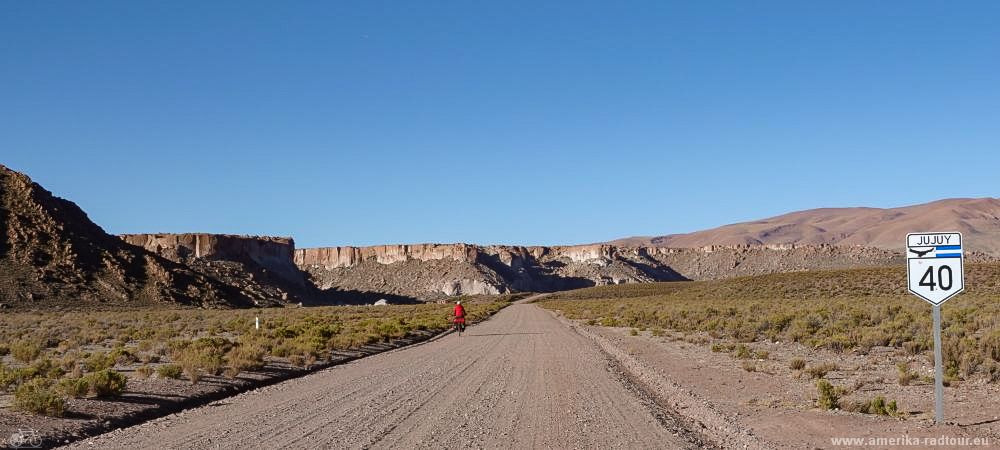 Todays stage from Puesto Sey to San Antonio de los Copres is one of the most spectacular routes I have ever had the pleasure of cycling. Cycling from Susques to Puesto Sey was very tiring, but today's stage makes up for everything, including all the efforts of the last few days. Which doesn't mean that today's stage is easy. That is definetly not the case. It is the beauty of the landscape that compensates us. Since we have some respect for the condition of the road, we leave early. Hours of daylight behind you are less valuable than hours of daylight ahead. But starting early comes with a price: it is very cold in the Puna in the morning, at the end of August the night temperature is well below freezing. Todays stage from Puesto Sey to San Antonio de los Copres is one of the most spectacular routes I have ever had the pleasure of cycling. Cycling from Susques to Puesto Sey was very tiring, but today's stage makes up for everything, including all the efforts of the last few days. Which doesn't mean that today's stage is easy. That is definetly not the case. It is the beauty of the landscape that compensates us. Since we have some respect for the condition of the road, we leave early. Hours of daylight behind you are less valuable than hours of daylight ahead. But starting early comes with a price: it is very cold in the Puna in the morning, at the end of August the night temperature is well below freezing. |
 After a kilometers, we ride our bicycles into a valley that the locals call “La Jugueteria,” which roughly means “toy store.” The toys are ignimbrites, huge pieces of stone that were created long tima ago by the activity of the surrounding volcanoes. Due to the extreme temperature fluctuations between day and night, tensions build up in the rock, which leads to individual pieces of stone breaking off. A process that has been going on for thousands of years and is far from over. These ignimbrits are lying around on the left and right of the street like toys for giants. After a kilometers, we ride our bicycles into a valley that the locals call “La Jugueteria,” which roughly means “toy store.” The toys are ignimbrites, huge pieces of stone that were created long tima ago by the activity of the surrounding volcanoes. Due to the extreme temperature fluctuations between day and night, tensions build up in the rock, which leads to individual pieces of stone breaking off. A process that has been going on for thousands of years and is far from over. These ignimbrits are lying around on the left and right of the street like toys for giants. |
 In the early morning the sun is still low in the sky and the valley is in shadow. Yo can't cycle along here without gloves. The valley is called "Quebrada de Agua Caliente" and from the name alone you can deduce good and bad news. The bad news: Ruta 40 shares the gorge with a river. The good news: the water should be warm. In the early morning the sun is still low in the sky and the valley is in shadow. Yo can't cycle along here without gloves. The valley is called "Quebrada de Agua Caliente" and from the name alone you can deduce good and bad news. The bad news: Ruta 40 shares the gorge with a river. The good news: the water should be warm. |
 The deeper we cycle into the valley, the more spectacular the rocks lying around us become. With the rock on the right, it is probably a matter of time before the remaining rock is blasted away and rolls into the valley. The deeper we cycle into the valley, the more spectacular the rocks lying around us become. With the rock on the right, it is probably a matter of time before the remaining rock is blasted away and rolls into the valley. |
 Some of the boulders in the Quebrada de Agua Caliente taper downwards and have a small contact area. Given the seismic activity in this region, it is surprising that the rocks have not yet fallen. Even if the rock offers protection against the wind, I would recomend not to camp in the immediate vicinity. Some of the boulders in the Quebrada de Agua Caliente taper downwards and have a small contact area. Given the seismic activity in this region, it is surprising that the rocks have not yet fallen. Even if the rock offers protection against the wind, I would recomend not to camp in the immediate vicinity. |
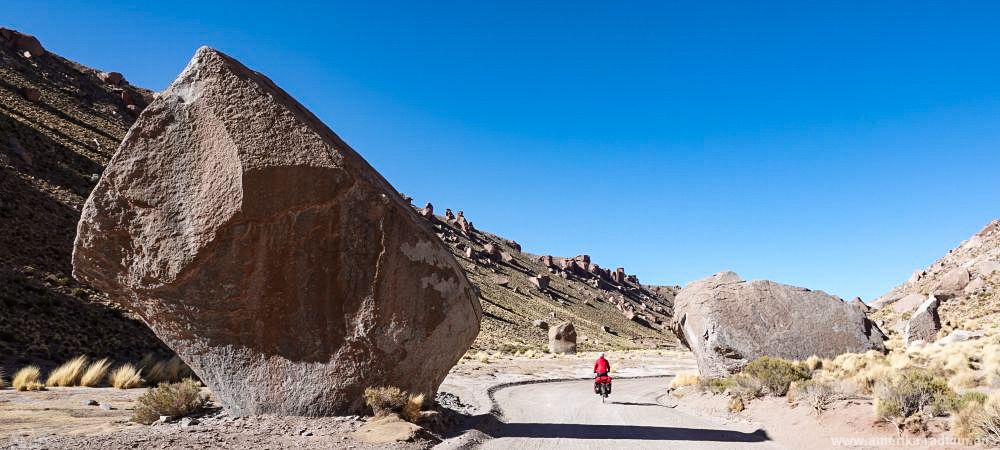 It's not like the boulders of La Jugueteria decided not to tumble onto Ruta 40. It's more like the road zigzags around the boulders. The traces in the terrain suggest that the course of the road has repeatedly adapted to the circumstances over the years. It's not like the boulders of La Jugueteria decided not to tumble onto Ruta 40. It's more like the road zigzags around the boulders. The traces in the terrain suggest that the course of the road has repeatedly adapted to the circumstances over the years. |
|
If a river and ta road share a gorge, then it can be assumed that the river claims the deepest channel of the gorge, while the road is build into the space left on both sides of the water. This inevitably means that we have to cross the river quite often. |
 On the right of the picture you can see a fenced off area: the fenced off rock has a crack that you can walk through. A legend says that when you walk through the gap you can make a wish, which will then come true. In return, you must return exactly one year after the visit and thank Pachamama with an offering. I couldn't find out why the wish stone is no longer accessible, but I don't assume that all wishes have been fulfilled by now. On the right of the picture you can see a fenced off area: the fenced off rock has a crack that you can walk through. A legend says that when you walk through the gap you can make a wish, which will then come true. In return, you must return exactly one year after the visit and thank Pachamama with an offering. I couldn't find out why the wish stone is no longer accessible, but I don't assume that all wishes have been fulfilled by now. |
 After a few kilometers the valley slowly opens up and we pass the last stones of the Jugueteria. Here, too, the road winds around the boulders lying around, the bottom of the valley is occupied river. After a few kilometers the valley slowly opens up and we pass the last stones of the Jugueteria. Here, too, the road winds around the boulders lying around, the bottom of the valley is occupied river. |
 One last time we cross the Agua Caliente, which only has a little water up here. Then the landscape suddenly shows itself from a completely different side. Unfortunally, with the steep slopes of the Quebrada de Agua Caliente, not only the gorge disappears but also our wind protection. One last time we cross the Agua Caliente, which only has a little water up here. Then the landscape suddenly shows itself from a completely different side. Unfortunally, with the steep slopes of the Quebrada de Agua Caliente, not only the gorge disappears but also our wind protection. |
 The terrain becomes more open, the puna gives us an impression of vastness and space. We feel quite small here on our bicycls. In this section, too, the Ruta 40 is in a well-maintained condition, although the road is sometimes made of fine sand, which makes cycling impossible. We have to push our bikes in the sandy sections. If you want to experience the fun of pushing a loaded touring bike through sand but are afraid of the long journey, I recommend the following: put the bike in a sandpit in winter, strap a crate of beer to the luggage rack and then push the bike for an hour in circles in the sandpit. Should be a similar fun. The terrain becomes more open, the puna gives us an impression of vastness and space. We feel quite small here on our bicycls. In this section, too, the Ruta 40 is in a well-maintained condition, although the road is sometimes made of fine sand, which makes cycling impossible. We have to push our bikes in the sandy sections. If you want to experience the fun of pushing a loaded touring bike through sand but are afraid of the long journey, I recommend the following: put the bike in a sandpit in winter, strap a crate of beer to the luggage rack and then push the bike for an hour in circles in the sandpit. Should be a similar fun. |
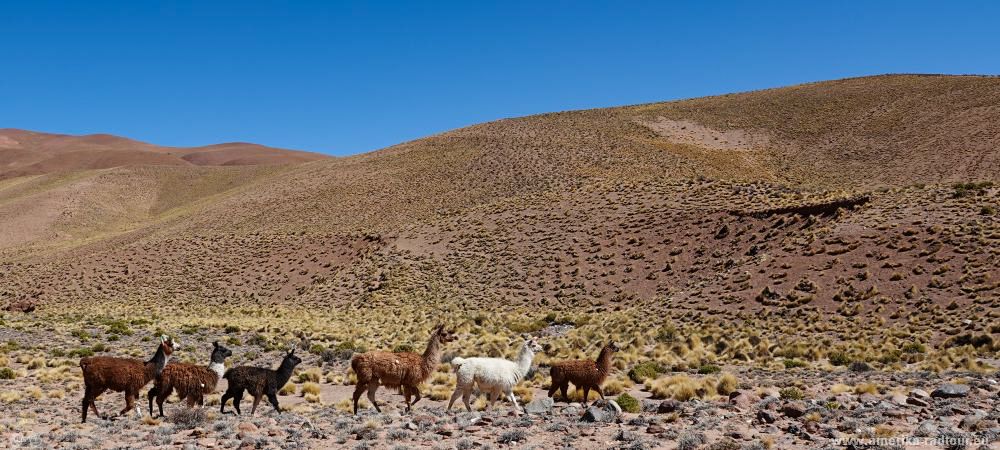 The llamas with their four-wheel drive cope better here. Interesting that the animals move in an orderly row. Since llamas live in a complex social community, I suspect that the order is not random but depends on the status of the animals. The llamas with their four-wheel drive cope better here. Interesting that the animals move in an orderly row. Since llamas live in a complex social community, I suspect that the order is not random but depends on the status of the animals. |
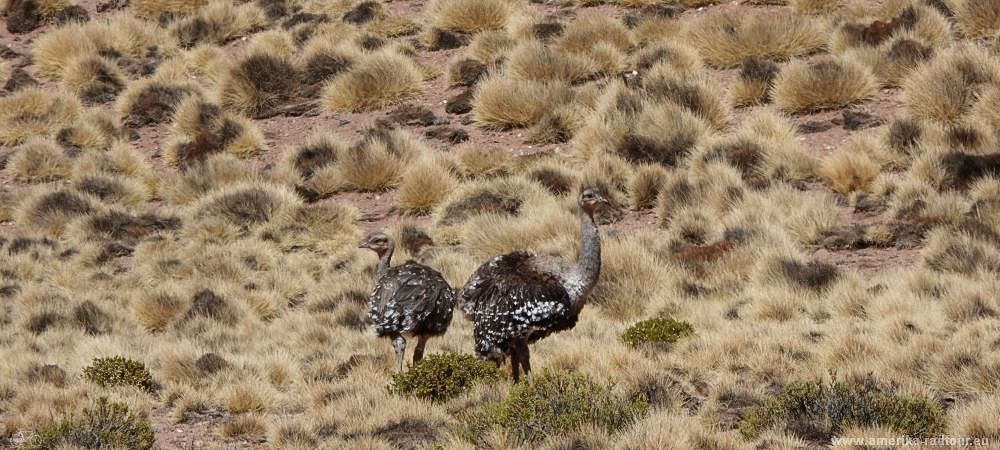 On the way we run into two rheas. The distinction between ostrich and rhea is very simple: there is no ostrich in South America, so it must be a rhea. Otherwise, you can tell the two species apart by their size: with a shoulder height of around 1.30m, the rhea is significantly smaller than the ostrich, which can easily peck on my head with its beak. At 25kg, rheas also weigh significantly less. Even if the movement of these animals, which cannot fly, seems a bit clumsy: when fleeing, a rheas reaches a speed of 60km/h. Without taking off. On the way we run into two rheas. The distinction between ostrich and rhea is very simple: there is no ostrich in South America, so it must be a rhea. Otherwise, you can tell the two species apart by their size: with a shoulder height of around 1.30m, the rhea is significantly smaller than the ostrich, which can easily peck on my head with its beak. At 25kg, rheas also weigh significantly less. Even if the movement of these animals, which cannot fly, seems a bit clumsy: when fleeing, a rheas reaches a speed of 60km/h. Without taking off. |
 On the open terrain of the Altiplano we are at the mercy of the wind. The landscape is monotonous, the only thing that changes is the wind. But today we are lucky because all of a sudden the wind changes direction slightly and we have tailwind. This is a rare experience: I have not often experienced a sustained tailwind on my bicycle. On the open terrain of the Altiplano we are at the mercy of the wind. The landscape is monotonous, the only thing that changes is the wind. But today we are lucky because all of a sudden the wind changes direction slightly and we have tailwind. This is a rare experience: I have not often experienced a sustained tailwind on my bicycle. |
|
We are now cycling south-west at an altitude of around 4400m and the wind is kind to us and is pushing us forward. Without pedaling we head towards San Antonio de los Cobres! Up here we are grateful for every support. If I could have wished for anything as I passed the Wishing Stone this morning, it would be this. |
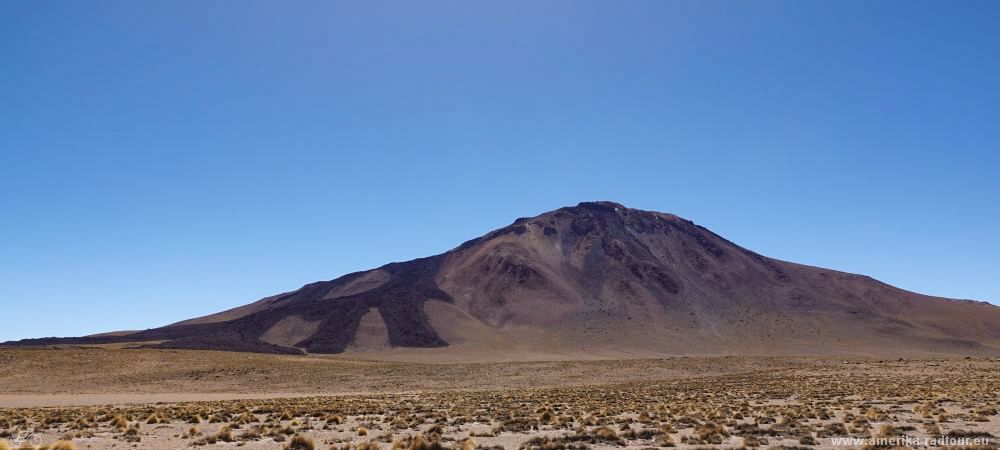 The Ruta 40 continues in an arc around the Tuzgle volcano. The volcano has a height of 5486m above sea level. Since we are on the Altiplano at about 4400m, the volcano looks more like a slight elevation. The volcano is a sleeping stratovolcano, which has been inactive for many millennia throughout Earth's history before becoming active again. The lava flows from the last eruption stand out in color from the volcanic cone. The Agua Caliente river also has its source in the Tuzgle area. The Ruta 40 continues in an arc around the Tuzgle volcano. The volcano has a height of 5486m above sea level. Since we are on the Altiplano at about 4400m, the volcano looks more like a slight elevation. The volcano is a sleeping stratovolcano, which has been inactive for many millennia throughout Earth's history before becoming active again. The lava flows from the last eruption stand out in color from the volcanic cone. The Agua Caliente river also has its source in the Tuzgle area. |
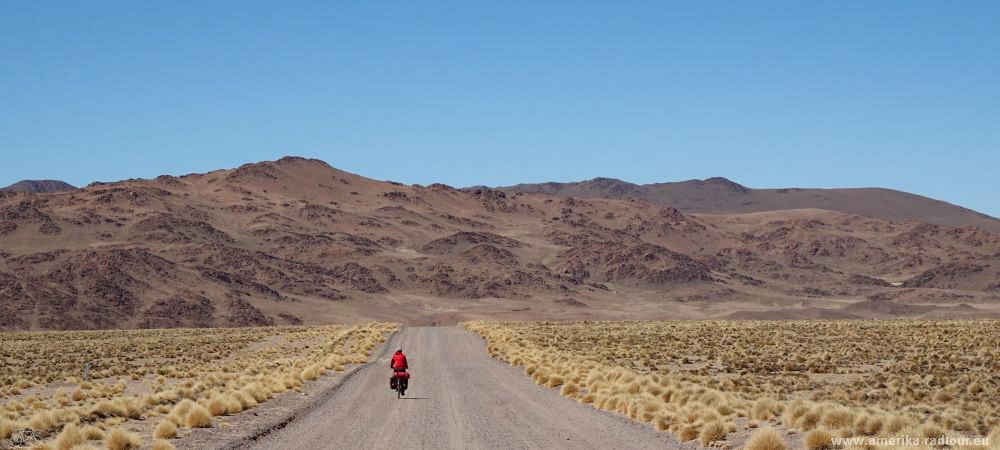 In the area of the Tuzgle volcano, Ruta 40 has reaches todays highest point. From now on we cycle downhill to San Antonio de los Cobres. However, this cannot be compared with a rushing descent in the Alps, as the nature of the road in some areas does not allow for more than walking speed. In the area of the Tuzgle volcano, Ruta 40 has reaches todays highest point. From now on we cycle downhill to San Antonio de los Cobres. However, this cannot be compared with a rushing descent in the Alps, as the nature of the road in some areas does not allow for more than walking speed. |
 Towards midday the landscape changes again: the flat plateau lies behind us and it becomes hilly again. The Ruta 40 meanders between various mountains, which are striking in their different colors due to their mineral- and ore-containing rock. Towards midday the landscape changes again: the flat plateau lies behind us and it becomes hilly again. The Ruta 40 meanders between various mountains, which are striking in their different colors due to their mineral- and ore-containing rock. |
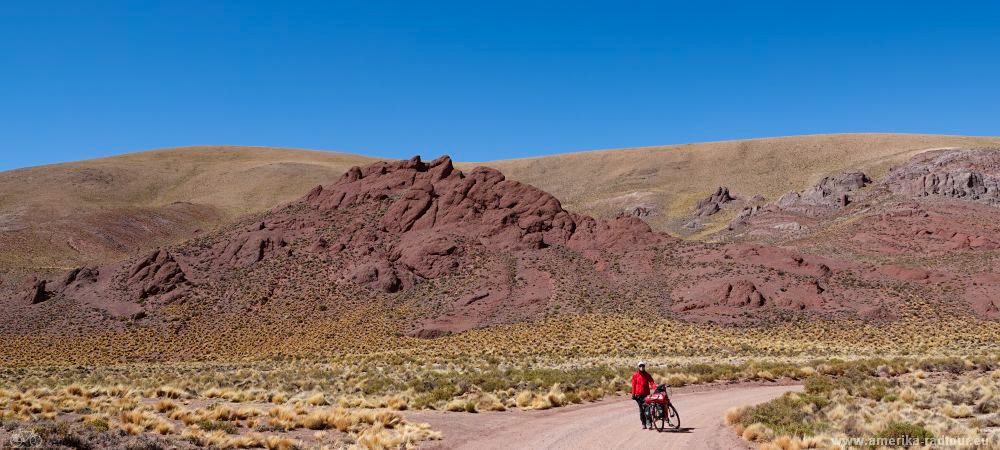 Not only are the intense colors of the rock astonishing, the color change that can be observed within short distances is also remarkable. If the landscape is just characterized by a yellow-green hue, around the next bend you find yourself standing in front of a red-brown rock. Not only are the intense colors of the rock astonishing, the color change that can be observed within short distances is also remarkable. If the landscape is just characterized by a yellow-green hue, around the next bend you find yourself standing in front of a red-brown rock. |
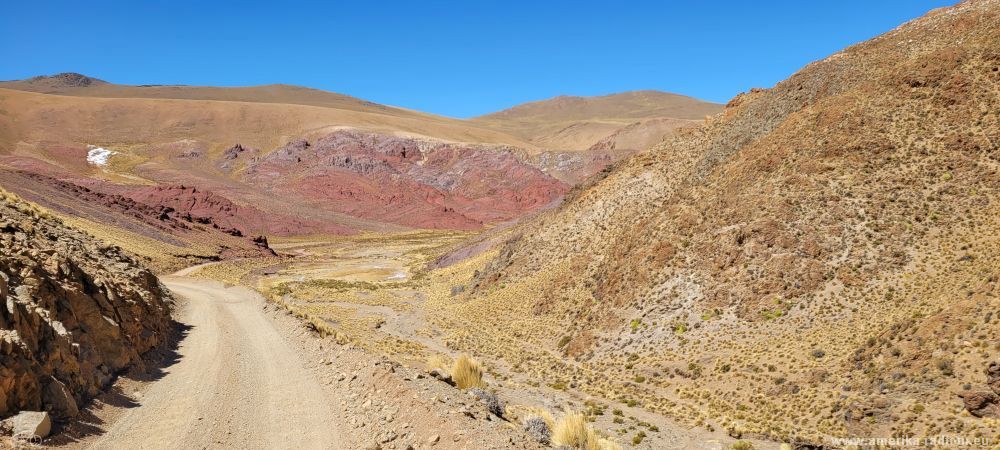 About 30 km / 19 mi south of Puesto Sey, Ruta 40 leaves the Puna Plateau and enters a valley that takes us down to San Antonio de los Cobres. The slope is unpaved, we drive on loose gravel, fine gravel and occasionally through sand. About 30 km / 19 mi south of Puesto Sey, Ruta 40 leaves the Puna Plateau and enters a valley that takes us down to San Antonio de los Cobres. The slope is unpaved, we drive on loose gravel, fine gravel and occasionally through sand. |
 The gradient is quite pleasant at -5%, braking is made difficult by the unpaved road. So we cycle slowly and take breaks every now and then to enjoy the landscape. In the areas with a low gradient and slow flow, the small stream we share this valley with is covered with a layer of ice despite the sunshine . The gradient is quite pleasant at -5%, braking is made difficult by the unpaved road. So we cycle slowly and take breaks every now and then to enjoy the landscape. In the areas with a low gradient and slow flow, the small stream we share this valley with is covered with a layer of ice despite the sunshine . |
 This is what Ruta Nacional 40 looks like north of San Antonio de los Cobres: if you drive this section of the road across Argentina's Puna, it would be better to have a four-wheel drive vehicle. Or on a bicycle. Bicycle works too. This is what Ruta Nacional 40 looks like north of San Antonio de los Cobres: if you drive this section of the road across Argentina's Puna, it would be better to have a four-wheel drive vehicle. Or on a bicycle. Bicycle works too. |
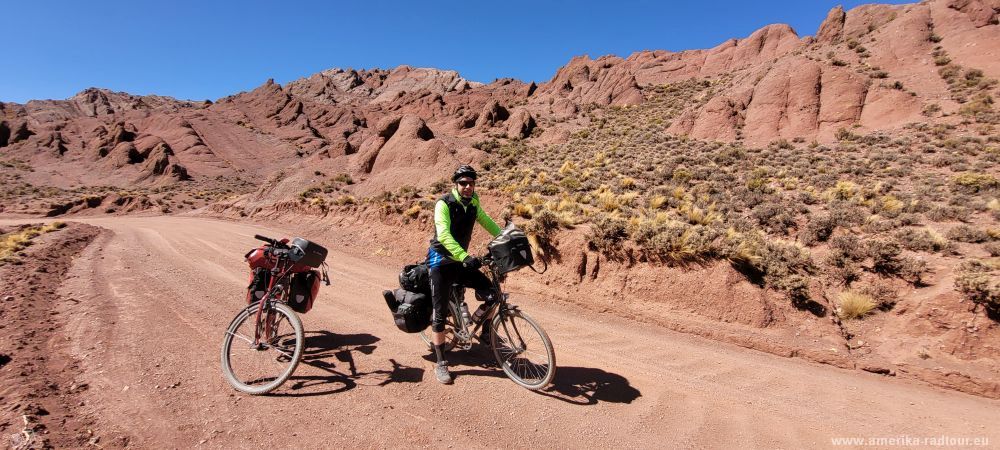 A few minutes later, Ruta 40 leads through a lunar landscape made of red rock. In the picture you can see that it is once again a corrugated washbord track. A few minutes later, Ruta 40 leads through a lunar landscape made of red rock. In the picture you can see that it is once again a corrugated washbord track. |
 North of San Antonio de los Cobres, Ruta 40 shares the valley with a mountain stream, but unlike this morning, the valley is very narrow and the track runs above the water on a slope. Therefore there is virtually no crossing point with the watercourse. North of San Antonio de los Cobres, Ruta 40 shares the valley with a mountain stream, but unlike this morning, the valley is very narrow and the track runs above the water on a slope. Therefore there is virtually no crossing point with the watercourse. |
 The deep red rocks alternate with the light rock. Over here it looks completely different every 100 meters. The only constants are the blue sky, the bumpy road and the strong wind. The deep red rocks alternate with the light rock. Over here it looks completely different every 100 meters. The only constants are the blue sky, the bumpy road and the strong wind. |
 The further we go downhill on Ruta 40, the narrower the valley becomes. At some point the valley becomes so narrow that crossing the mountain stream becomes unavoidable. Since the stream has very little water (beginning of September), driving through the fords is not a problem. The further we go downhill on Ruta 40, the narrower the valley becomes. At some point the valley becomes so narrow that crossing the mountain stream becomes unavoidable. Since the stream has very little water (beginning of September), driving through the fords is not a problem. |
 A few kilometers later the time has come: in the valley in front of us we can see the Viaducto la Polvorilla, one of the highest railway bridges in the world. The steel construction can be seen from afar, but we only approach it slowly due to our slow pace. From the far distance the viaduct doesn't look spectacularly large. A few kilometers later the time has come: in the valley in front of us we can see the Viaducto la Polvorilla, one of the highest railway bridges in the world. The steel construction can be seen from afar, but we only approach it slowly due to our slow pace. From the far distance the viaduct doesn't look spectacularly large. |
 But the closer we get to the Viaducto la Polvorilla, the more impressive the construction appears. One last crossing of the small mountain stream, then we cycle under the 224m / 735ft long viaduct that leads 63m / 207ft over Ruta 40. The pillar viaduct consists of 7 fields, each 20m / 66ft long. The structure was built between 1930 and 1932, at a time when there were no CAD programs that could automatically create any parts lists and no CAE programs that could calculate forces and stresses in the struts. What a great piece of engineering! But the closer we get to the Viaducto la Polvorilla, the more impressive the construction appears. One last crossing of the small mountain stream, then we cycle under the 224m / 735ft long viaduct that leads 63m / 207ft over Ruta 40. The pillar viaduct consists of 7 fields, each 20m / 66ft long. The structure was built between 1930 and 1932, at a time when there were no CAD programs that could automatically create any parts lists and no CAE programs that could calculate forces and stresses in the struts. What a great piece of engineering! |
 The viaduct is part of the railway line from Buenos Aires via Salta to Antofagasta in Chile. The route winds through 44 bridges, 21 tunnels and 13 viaducts and, due to a maximum gradient of 2.5%, does not require teh technics of rack railways . When it went into operation in 1958, the travel time from Buenos Aires to Antofagasta was reduced to 4 days. Today the route to the Pacific is only used for freight transport. The Viaducto la Polvorille is the highlight of the journey on the Tren a las Nubes passenger train, the train to the clouds, although this tourist attraction no longer has anything to do with a train journey: passengers are taken by bus from Salta to San Antonio de los Cobres (that alone takes 6 hours), then get on the train and are transported the approximately 20km to the viaduct and back to San Antonio. On a track next to the railway line, the train is accompanied by an ambulance vehicle, as the majority of the passengers had breakfast in Salta early in the morning and are experiencing health problems due to the thin air up here. The viaduct is part of the railway line from Buenos Aires via Salta to Antofagasta in Chile. The route winds through 44 bridges, 21 tunnels and 13 viaducts and, due to a maximum gradient of 2.5%, does not require teh technics of rack railways . When it went into operation in 1958, the travel time from Buenos Aires to Antofagasta was reduced to 4 days. Today the route to the Pacific is only used for freight transport. The Viaducto la Polvorille is the highlight of the journey on the Tren a las Nubes passenger train, the train to the clouds, although this tourist attraction no longer has anything to do with a train journey: passengers are taken by bus from Salta to San Antonio de los Cobres (that alone takes 6 hours), then get on the train and are transported the approximately 20km to the viaduct and back to San Antonio. On a track next to the railway line, the train is accompanied by an ambulance vehicle, as the majority of the passengers had breakfast in Salta early in the morning and are experiencing health problems due to the thin air up here. |
 As we drive under the viaduct, the size of the structure becomes clear. Marion on her bike is smaller than the concrete foundation of the truss pillars. The viaduct has a mass of 1,600 tons, was manufactured in Italy and brought to Argentina in small pieces to be assembled on site. As we drive under the viaduct, the size of the structure becomes clear. Marion on her bike is smaller than the concrete foundation of the truss pillars. The viaduct has a mass of 1,600 tons, was manufactured in Italy and brought to Argentina in small pieces to be assembled on site. |
 South of the viaduct there is a parking lot for day tourists comming from San Antonio. Here we take a break and eat the eggs we cooked yesterday at 4000m. The cooking time of 16:30 minutes is perfect! In the valley, which is still narrow here, we sit very sheltered from the wind and enjoy the sun. There are several cars in the parking lot and it seems as if the remaining route down to San Antonio de los Cobres is easy to manage. But that's not the case. South of the viaduct there is a parking lot for day tourists comming from San Antonio. Here we take a break and eat the eggs we cooked yesterday at 4000m. The cooking time of 16:30 minutes is perfect! In the valley, which is still narrow here, we sit very sheltered from the wind and enjoy the sun. There are several cars in the parking lot and it seems as if the remaining route down to San Antonio de los Cobres is easy to manage. But that's not the case. |
 Ruta 40 runs under the viaduct at an altitude of 4150m, the town of San Antonio de los Cobres is at around 3775m. But the descent is anything but easy. The road surface is in surprisingly poor condition made of gravel and sand. On our way we pass the abandoned mine 'La Concordia', which was used to extract gold, silver and lead in the 19th century, but is abandoned now. From the looksof it, mines aren't shut down here, they're just left behind. Ruta 40 runs under the viaduct at an altitude of 4150m, the town of San Antonio de los Cobres is at around 3775m. But the descent is anything but easy. The road surface is in surprisingly poor condition made of gravel and sand. On our way we pass the abandoned mine 'La Concordia', which was used to extract gold, silver and lead in the 19th century, but is abandoned now. From the looksof it, mines aren't shut down here, they're just left behind. |
 This section is easy to pass for four-wheel drive vehicles; the loose gravel appears to be regularly leveled with heavy equipment. However, with our bibycles we have slight problems. To make matters worse, traffic on this section is stopped by emergency services because a tourist from Ten de las Nubes fell over due to the thin air and had to be taken to San Antonio in an ambulance. The entire traffic, consisting of us on our two bcycles and a vehicle from a mining company, is stopped by a marshal and we have to wait 10 minutes until we can continue. This section is easy to pass for four-wheel drive vehicles; the loose gravel appears to be regularly leveled with heavy equipment. However, with our bibycles we have slight problems. To make matters worse, traffic on this section is stopped by emergency services because a tourist from Ten de las Nubes fell over due to the thin air and had to be taken to San Antonio in an ambulance. The entire traffic, consisting of us on our two bcycles and a vehicle from a mining company, is stopped by a marshal and we have to wait 10 minutes until we can continue. |
 In large sections the piste consists of fine, floury sand into which the wheels sink deeply. Eventually we reach the main street, Avenida Ingeniero Mario Banchik, which leads from San Antonio de los Cobres to Chile and down into the Atacama region. San Antonio de los Cobres is located at an altitude of 3775m, has around 4000 inhabitants and used to live from the copper mines in the surrounding ore-rich mountains. Today, in addition to tourism, for which the Tren a las Nubes is essential, public administration is the largest employer. After our arrival in San Antonio, we cycle to our hotel and enjoy the luxury of a room with private bathroom, running hot water and heating. After a long shower, we find an excellent restaurant in the town and have a good meal with a fine bottle Argentinian of red wine. In large sections the piste consists of fine, floury sand into which the wheels sink deeply. Eventually we reach the main street, Avenida Ingeniero Mario Banchik, which leads from San Antonio de los Cobres to Chile and down into the Atacama region. San Antonio de los Cobres is located at an altitude of 3775m, has around 4000 inhabitants and used to live from the copper mines in the surrounding ore-rich mountains. Today, in addition to tourism, for which the Tren a las Nubes is essential, public administration is the largest employer. After our arrival in San Antonio, we cycle to our hotel and enjoy the luxury of a room with private bathroom, running hot water and heating. After a long shower, we find an excellent restaurant in the town and have a good meal with a fine bottle Argentinian of red wine. |




